Abstract
Imatinib mesylate (STI571) is effective in chronic phase chronic myelogenous leukemia (CML). However, most patients treated with 400 mg imatinib daily have variable levels of residual molecular disease. We treated 114 patients with newly diagnosed chronic phase CML with 400 mg imatinib twice daily. Overall, 109 patients (96%) had a major cytogenetic response (Philadelphia chromosome [Ph] < 35%), and 103 (90%) had a complete response (Ph 0%). With a median follow-up of 15 months, no patient has progressed to accelerated or blastic phase. The estimated 2-year survival rate was 94%. By quantitative polymerase chain reaction (QPCR) studies, 71 (63%) of 112 patients showed BCR-ABL/ABL percentage ratios decrease to less than 0.05%, and 31 (28%) to undetectable levels. Compared with standard-dose imatinib, high-dose imatinib was associated with significantly better complete cytogenetic response (P = .0005), major molecular response (QPRC < 0.05%; P = .00001), and complete molecular response (undetectable BCR-ABL; P = .001). High-dose imatinib was well tolerated but resulted in more frequent myelosuppression; 82% of patients continue to receive 600 mg or more of imatinib daily. In conclusion, high-dose imatinib induced higher rates of complete cytogenetic response and of molecular response in patients with newly diagnosed chronic phase CML. (Blood. 2004; 103:2873-2878)
Introduction
Imatinib mesylate (STI571, Gleevec; Novartis Pharmaceuticals, East Hanover, NJ) is a selective Bcr-Abl protein tyrosine kinase inhibitor against c-abl, bcr/abl, c-kit, and platelet-derived growth factor receptor (PDGF-R).1,2 Imatinib has demonstrated significant activity in all phases of Philadelphia chromosome (Ph)–positive chronic myeloid leukemia (CML).3-12 The recommended dosage is 400 mg daily for chronic phase CML and 600 mg daily for CML in transformation. In patients with previously untreated early chronic phase CML, 400 mg imatinib orally daily has produced complete hematologic responses (CHRs) in more than 95% of patients, and complete cytogenetic responses in 60% to 75%.11,12 However, patients with undetectable levels of BCR-ABL assessed by polymerase chain reaction (PCR) studies (complete molecular response) represented only 5% to 15%. Achievement of a complete cytogenetic response with interferon alpha (IFN-α) has been associated with 10-year survival rates of 70% to 85%.13-17 Patients with undetectable BCR-ABL levels after IFN-α have not relapsed after long-term follow-up.13,15 Thus, while achievement of a complete cytogenetic response is an important short-term goal in CML therapy, reaching undetectable levels of BCR-ABL may improve long-term event-free survival.
Several observations suggest that higher dosages of imatinib may be more effective. The initial phase 1 trial showed a clear dose-response relationship.3 Complete hematologic response rates were 98% with daily imatinib doses of 300 mg or higher, compared with 56% with 200 or 250 mg daily, and lower rates with dosages less than 200 mg. Cytogenetic responses were 54% with dosages 300 mg/day or higher, but were rare at lower dosages. In accelerated phase CML, patients treated with 600 mg imatinib daily had higher response rates, and longer response and survival durations.7 In chronic phase CML after IFN-α failure, imatinib dosage escalation to 800 mg daily after CML relapse at 400 mg daily recaptured CHR in 60% of patients and improved cytogenetic response to a major one in 40%.18 Amplification of the BCR-ABL gene or overexpression of its protein product are known mechanisms of resistance. Several mutations within the Abl structure in Bcr-Abl result in relative rather than absolute resistance to imatinib. Some resistance mechanisms may be overcome with imatinib dosage escalation.19-22
We have recently treated 36 patients in late chronic CML after IFN-α failure with 400 mg imatinib orally twice daily. The complete cytogenetic response rate was 89%, and 41% had undetectable levels of BCR-ABL.23 These results appear to be significantly better than with 400 mg imatinib daily in chronic phase CML after IFN-α failure.5,6 In this study, we investigated the efficacy and toxicity of high-dose imatinib (800 mg daily) in newly diagnosed CML, and compared the results with standard-dose imatinib (400 mg daily) in a similar CML population.
Patients and methods
Study group
Patients with newly diagnosed Ph-positive CML in early chronic phase (diagnosis to therapy < 12 months) were eligible for our institutional investigational new drug (IND) study (ID-01_151). Patients were required to be 15 years or older and to have adequate performance status (Eastern Cooperative Oncology Group [ECOG], 0 to 2), serum creatinine less than 176.8 μM (2 mg/dL), total bilirubin less than 34.2 μM (2 mg/dL), and normal cardiac function (New York Heart Association class 3-4 cardiac disease excluded). Patients previously treated with imatinib were not eligible; prior therapy with hydroxyurea was allowed, but prior therapy with IFN-α or cytarabine was allowed only for a month or less. Women of childbearing age were required to have a negative pregnancy test before starting imatinib, and all patients at risk were required to use contraception during therapy. Patients provided written informed consent before entry into the study; the study was reviewed and approved by the internal review board of our institution (M.D. Anderson Cancer Center) and performed in accordance with the Declaration of Helsinki.
Treatment and dose modifications
Imatinib was given orally at 400 mg twice daily. Hydroxyurea was allowed for debulking during the first 4 weeks of therapy. Anagrelide was permitted for up to 3 weeks.
Dose reductions of imatinib for nonhematologic or hematologic toxic effects were as follows. For persistent grade 2 nonhematologic toxic effects, therapy was interrupted until recovery to grade 1 or less and resumed at the original dosage level. If grade 2 toxicity recurred, treatment was interrupted again until recovery and resumed at a daily dosage of 600 mg. For grade 3 or 4 nonhematologic toxicity, therapy was interrupted until recovery to grade 1 or less and resumed at a daily dosage of 600 mg. For severe hematologic toxicity (granulocyte count of < 0.5 × 109/L or a platelet count of < 40 × 109/L), therapy was interrupted until the neutrophils recovered to 109/L or higher and/or platelets to 60 × 109/L or higher. If the toxicity resolved within 2 weeks, treatment was resumed at the original dosage. If toxicity resolved after more than 2 weeks, or if it recurred after resuming therapy, the dosage was reduced to 600 mg. Further dose reductions to 400 mg or 300 mg daily were allowed using the same guidelines for hematologic and nonhematologic toxicity. Patients developing anemia received packed red blood cell transfusions or blood products at the discretion of the investigator, or 40 000 units erythropoietin subcutaneously once a week until the hemoglobin level increased to 120 g/L (12 g/dL) or more.
Monitoring
Complete blood counts and serum chemistry were done weekly during the first 4 weeks, then every 6 to 8 weeks thereafter. Bone marrow studies, including morphologic and cytogenetic or fluorescent in situ hybridization (iFISH) analysis, and quantitative PCR studies, were performed every 3 months in the first year, then every 3 to 6 months. Patients were followed for survival at least every 3 months. Drug safety parameters were evaluated at each visit and graded according to the National Cancer Institute Common Toxicity Criteria (NCI CTC), version 2.0.
Statistical considerations
Response criteria were as previously described.26 A CHR was defined as a white blood cell count of less than 10 × 109/L, a platelet count of less than 450 × 109/L, no immature cells (blasts, promyelocytes, myelocytes) in the peripheral blood, and disappearance of all signs and symptoms related to leukemia (including palpable splenomegaly) lasting for at least 4 weeks. Response was further categorized by the best cytogenetic response: complete, 0% Ph-positive cells; partial, 1% to 34% Ph-positive cells; and minor, 35% to 90% Ph-positive cells. Major cytogenetic response included complete plus partial cytogenetic responses (Ph-positive cells 0%-34%). Cytogenetic response was judged by standard cytogenetic analysis of metaphase spreads. Patients were categorized by their best cytogenetic or molecular response. Differences among variables were compared by the chi-square test. Time to disease transformation was calculated from the time treatment began until appearance of accelerated or blastic phase disease. Survival was calculated from the time treatment began until death from any cause. Survival and time to event curves were estimated by the Kaplan-Meier method and compared by the log rank test.
Cytogenetic and PCR analysis
Cytogenetic analysis was performed by the G-banding technique. Marrow specimens were examined on direct or short-term (24-hour) cultures; at least 20 metaphases were analyzed. PCR was done by real-time reverse transcriptase–PCR, and negative results (ie, undetectable transcript) were confirmed by nested PCR as previously reported.27 The sensitivity of the test is 1:100 000. The quantitative PCR (QPCR) analysis measured the BCR-ABL/ABL percentage ratio. For the purpose of this analysis, a complete molecular response was defined as negative (undetectable) BCR-ABL levels. A major molecular response was defined as BCR-ABL/ABL values less than 0.05%. This was based on previous studies identifying BCR-ABL/ABL values of 0.045% to 0.1% to be prognostically important.28,29 A BCR-ABL/ABL ratio of 0.05% is roughly equivalent to a 3-log reduction in disease.30
Historical control group
For comparative purposes, 50 patients with newly diagnosed Ph-positive CML treated on an institutional IND study (ID01-015) with 400 mg imatinib orally daily were analyzed. All patients were entered in the study from April to May 2001.11 The study of the historical control group immediately preceded the current study (which entered patients from June 2001 until April 2003).
Results
Study group
From June 2001 until April 2003, 114 patients were enrolled on the institutional IND study (ID-01_151). Their median age was 48 years (range, 17-84 years). Risk group (Sokal) stratification for 99 patients with evaluable data was as follows: good, 41%; intermediate, 37%; and poor, 21%. Their characteristics are summarized in Table 1. There were 50 patients (44%) who had received other therapies (IFN-α, 1; hydrea, 49). There were 6 patients (5%) who had cytogenetic clonal evolution (other than complex Ph translocations or loss of chromosome Y): 3 with double Ph, 3 with other abnormalities. The median follow-up of the study group was 15 months and of the historical control group 31 months.
Characteristics of the study and historical control groups
. | No. (%) . | . | . | ||
|---|---|---|---|---|---|
| Parameter . | Study group . | Historical group . | P . | ||
| Age, 60 y or older [median age, y] | 31 (27)[48] | 13 (26)[48] | 1.0 | ||
| Female sex | 44 (39) | 24 (48) | .34 | ||
| Performance status 2 | 2 (2) | 0 (0) | 1.0 | ||
| Splenomegaly | 31 (27) | 11 (22) | .56 | ||
| Diagnosis to therapy, mo [median time, mo] | [1] | [2] | |||
| 0 | 19 (17) | 5 (10) | .34 | ||
| 1 to 11 | 95 (83) | 45 (90) | |||
| Hemoglobin level [median level, g/L] | [123] | [125] | |||
| Less than 100 g/L | 3 (3) | 3 (6) | .37 | ||
| WBC count, × 109/L [median count, × 109/L] | [32.2] | [22.5] | |||
| 50 or higher | 41 (36) | 11 (22) | .1 | ||
| Platelet count, × 109/L [median count, × 109/L] | [375] | [382] | |||
| 450 to 700 | 27 (24) | 11 (22) | .76 | ||
| Higher than 700 | 18 (16) | 6 (12) | |||
| Peripheral blasts, any | 42 (37) | 14 (28) | .29 | ||
| Peripheral basophils, 7% or more | 29 (25) | 10 (20) | .55 | ||
| Marrow blasts, more than 5% | 6 (5) | 0 (0) | .18 | ||
| Marrow basophils, 5% or more | 26 (23) | 7 (14) | .21 | ||
| Clonal evolution present | 6 (5) | 0 (0) | .18 | ||
| Sokal risk group | .14 | ||||
| Low | 41 (36) | 24 (48) | |||
| Intermediate | 37 (32) | 12 (24) | |||
| High | 21 (18) | 12 (24) | |||
| Unknown | 15 (13) | 2 (4) | |||
. | No. (%) . | . | . | ||
|---|---|---|---|---|---|
| Parameter . | Study group . | Historical group . | P . | ||
| Age, 60 y or older [median age, y] | 31 (27)[48] | 13 (26)[48] | 1.0 | ||
| Female sex | 44 (39) | 24 (48) | .34 | ||
| Performance status 2 | 2 (2) | 0 (0) | 1.0 | ||
| Splenomegaly | 31 (27) | 11 (22) | .56 | ||
| Diagnosis to therapy, mo [median time, mo] | [1] | [2] | |||
| 0 | 19 (17) | 5 (10) | .34 | ||
| 1 to 11 | 95 (83) | 45 (90) | |||
| Hemoglobin level [median level, g/L] | [123] | [125] | |||
| Less than 100 g/L | 3 (3) | 3 (6) | .37 | ||
| WBC count, × 109/L [median count, × 109/L] | [32.2] | [22.5] | |||
| 50 or higher | 41 (36) | 11 (22) | .1 | ||
| Platelet count, × 109/L [median count, × 109/L] | [375] | [382] | |||
| 450 to 700 | 27 (24) | 11 (22) | .76 | ||
| Higher than 700 | 18 (16) | 6 (12) | |||
| Peripheral blasts, any | 42 (37) | 14 (28) | .29 | ||
| Peripheral basophils, 7% or more | 29 (25) | 10 (20) | .55 | ||
| Marrow blasts, more than 5% | 6 (5) | 0 (0) | .18 | ||
| Marrow basophils, 5% or more | 26 (23) | 7 (14) | .21 | ||
| Clonal evolution present | 6 (5) | 0 (0) | .18 | ||
| Sokal risk group | .14 | ||||
| Low | 41 (36) | 24 (48) | |||
| Intermediate | 37 (32) | 12 (24) | |||
| High | 21 (18) | 12 (24) | |||
| Unknown | 15 (13) | 2 (4) | |||
Populations are as follows: study group, N = 114; historical group, N = 50.
Response
Of the patients, 112 (98%) achieved CHR (Table 2). A major cytogenetic response was noted in 109 patients (96%): complete in 103 (90%) and partial in 6 (5%). Complete cytogenetic response was achieved in 59 patients (52%) at 3 months of therapy, and in 94 (82%) at 6 months. Compared with standard-dose imatinib, high-dose imatinib was associated with achievement of significantly better complete cytogenetic responses (P = .0005; Figure 1). Patients with Sokal high risk had a lower complete cytogenetic response rate (76% versus 95%; P = .03). There were no other significant differences in the incidence of complete cytogenetic response by known prognostic factors (eg, older age, splenomegaly, thrombocytosis) within the small numbers involved. All 6 patients with clonal evolution achieved a complete cytogenetic response (and disappearance of cytogenetic clonal evolution).
Response to imatinib mesylate therapy
. | No. (%) . | . | . | |
|---|---|---|---|---|
| Response . | Study group . | Historical group . | P . | |
| Complete hematologic | 112 (98) | 49 (98) | — | |
| Cytogenetic | 110 (96) | 49 (98) | — | |
| Complete | 103 (90) | 37 (74) | .01 | |
| Partial | 6 (5) | 9 (18) | — | |
| Minor | 1 (1) | 3 (6) | — | |
. | No. (%) . | . | . | |
|---|---|---|---|---|
| Response . | Study group . | Historical group . | P . | |
| Complete hematologic | 112 (98) | 49 (98) | — | |
| Cytogenetic | 110 (96) | 49 (98) | — | |
| Complete | 103 (90) | 37 (74) | .01 | |
| Partial | 6 (5) | 9 (18) | — | |
| Minor | 1 (1) | 3 (6) | — | |
Populations are as follows: study group, N = 114; historical group, N = 50. —indicates lack of statistical significance.
Estimated cumulative incidence of complete cytogenetic response in the study and historical control groups. CR indicates complete response.
Estimated cumulative incidence of complete cytogenetic response in the study and historical control groups. CR indicates complete response.
Figure 2 shows the values of BCR-ABL/ABL percentage ratio during imatinib therapy. There was a consistent and significant decline of these ratios over time. The median BCR-ABL/ABL percentage ratio decreased from 0.90% (range, 0%-107%) after 3 months to 0.030% (range, 0%-51%) after 12 months of therapy. Of 112 patients evaluable for molecular response, 71 (63%) achieved ratios of less than 0.05%, including 31 patients (28%) who had undetectable transcripts (confirmed by nested PCR). There were 48 patients who had at least 2 consecutive PCR values less than 0.05%, and 10 patients had at least 2 consecutive analyses with undetectable transcripts. Compared with standard-dose imatinib, patients receiving high-dose imatinib achieved significantly better major (BCR-ABL/ABL ratio < 0.05%; Figure 3; P = .00001) and complete (BCR-ABL/ABL negative ratio; Figure 4; P = .001) molecular responses. The estimated cumulative 18-month incidence of complete molecular response was 28% with high-dose imatinib versus 7% with standard-dose imatinib.
BCR-ABL/ABL percentage ratio over the course of therapy. Results are expressed for each evaluable patient at each 3-month period. Number of evaluable patients is shown on top. The dotted line represents a percentage ratio of 0.05%. Percentages shown under this line represent the proportion of patients below this threshold at each time point.
BCR-ABL/ABL percentage ratio over the course of therapy. Results are expressed for each evaluable patient at each 3-month period. Number of evaluable patients is shown on top. The dotted line represents a percentage ratio of 0.05%. Percentages shown under this line represent the proportion of patients below this threshold at each time point.
Estimated cumulative incidence of major molecular response (BCR-ABL/ABL ratio < 0.05%) in the study and historical control groups.
Estimated cumulative incidence of major molecular response (BCR-ABL/ABL ratio < 0.05%) in the study and historical control groups.
Estimated cumulative incidence of complete molecular response (undetectable BCR-ABL levels, confirmed by nested QPCR) in the study and historical control groups.
Estimated cumulative incidence of complete molecular response (undetectable BCR-ABL levels, confirmed by nested QPCR) in the study and historical control groups.
Time to progression and survival
Of the 114 patients treated, 96 (84%) remain alive in chronic phase on imatinib therapy. The other 18 patients stopped therapy because of noncompliance (n = 4), insurance issues (n = 3), toxicity (n = 7), cytogenetic refractoriness (n = 3), and death unrelated to imatinib (n = 1). After a median follow-up of 15 months (range, 3-27 months), 112 patients (98%) are alive in chronic phase. Among all patients, 2 died—one from complications of allogeneic stem cell transplantation done in chronic phase (100% Ph-positive at 6 months) and the second of unrelated causes. None of the 114 patients have transformed; transformation-free status was better with high-dose imatinib (Figure 5; P = .004). Only 3 of 167 patients on either study have died (Figure 6). No patient in the current study group has developed chromosomal abnormalities in the emerging Ph-negative cells (2 did so in the historical group).
Estimated transformation-free status with high-dose versus standard-dose imatinib.
Estimated transformation-free status with high-dose versus standard-dose imatinib.
Response duration
Of the 109 patients with a major cytogenetic response, 11 were taken off therapy for issues not related to response (noncompliance, 2; insurance, 2; toxicity, 6; death, 1). Of 98 patients with a major cytogenetic response continuing therapy, 95 continue to have a durable major response: 3 patients had disease relapse (defined as either reappearance of Ph-positive cells ≥ 10% after complete cytogenetic response, or an increase of Ph-positive cells by 30% or more, or an increase to 65% or more documented once) after 4, 6, and 18 months from the time the major cytogenetic response was achieved. After a median follow-up time of 10 months from complete cytogenetic response (range, 1-24 months), only 1 (1%) of 103 patients who achieved a complete cytogenetic response has lost his response (to 85% Ph-positive). Among the 10 patients alive and off imatinib for reasons other than response, 2 of 9 who were in complete cytogenetic response had an increase of Ph-positive cells to 10% and 30%, respectively. The patient who stopped therapy while in partial cytogenetic response continues with this response. The median follow-up time from achievement of BCR-ABL/ABL percentage ratio of less than 0.05% is 10 months (range, 1-21 months). None of the 71 patients who have achieved these ratios had a cytogenetic relapse; 11 of 71 patients have had an increased ratio to more than 0.05% intermittently.
Toxicity and dose intensity
Common adverse events are listed in Table 3. Fluid retention, skin rash, nausea, diarrhea, and muscle cramps were common, but similar in frequency with that seen with standard-dose imatinib. Grade 3 or higher nonhematologic adverse events were uncommon: skin rash (n = 7, 6%), cardiac (n = 4, 4%), liver toxicity (n = 8, 7%), bone pain (n = 3, 3%), nausea and vomiting, diarrhea, fluid retention, and fatigue (1 patient each, total 4). All toxicities were reversible with dose reductions or treatment interruptions. Hematologic toxicity is also shown in Table 3: grade 3 or higher neutropenia in 41 patients (36%), thrombocytopenia in 29 patients (25%), and anemia in 11 (10%).
Severe side effects with high-dose versus standard-dose imatinib
. | No. (%) with grades 3-4 toxicity . | . | |
|---|---|---|---|
| Toxicity . | Study group . | Historical control . | |
| Fluid retention | 1 (1) | 0 (0) | |
| Bone pain | 3 (3) | 1 (2) | |
| Skin rash | 7 (6) | 3 (6) | |
| Fatigue | 1 (1) | 1 (2) | |
| Nausea/vomiting | 1 (1) | 0 | |
| Diarrhea | 1 (1) | 0 | |
| Abnormal liver function tests | 8 (7) | 5 (10) | |
| Cardiac | 4 (4) | 1 (2) | |
| Anemia* | 11 (10) | 2 (4) | |
| Neutropenia | 41 (36) | 10 (20) | |
| Thrombocytopenia | 29 (25) | 6 (12) | |
. | No. (%) with grades 3-4 toxicity . | . | |
|---|---|---|---|
| Toxicity . | Study group . | Historical control . | |
| Fluid retention | 1 (1) | 0 (0) | |
| Bone pain | 3 (3) | 1 (2) | |
| Skin rash | 7 (6) | 3 (6) | |
| Fatigue | 1 (1) | 1 (2) | |
| Nausea/vomiting | 1 (1) | 0 | |
| Diarrhea | 1 (1) | 0 | |
| Abnormal liver function tests | 8 (7) | 5 (10) | |
| Cardiac | 4 (4) | 1 (2) | |
| Anemia* | 11 (10) | 2 (4) | |
| Neutropenia | 41 (36) | 10 (20) | |
| Thrombocytopenia | 29 (25) | 6 (12) | |
Populations are as follows: study group, N = 114; historical control, N = 50.
P values for differences were as follows: anemia, P = .35; neutropenia, P = .05; and thrombocytopenia, P = .06.
After 3 months of therapy, 77 (68%) of 114 patients were receiving the planned dosage; 37 patients (32%) had dose reduction for toxicity to 600 mg daily (n = 27) or 300 to 400 mg daily (n = 10; Figure 7). The imatinib dosage of 800 mg daily was maintained in 70 (64%) of 109 evaluable patients at 6 months, and in 52 (66%) of 79 evaluable patients at 12 months. Dose reduction to 600 mg daily resolved the toxicity in most patients; 22 patients (19%) have required dose reductions to 400 mg daily or lower (300 mg is the lowest acceptable dose); 12 patients have required dose reductions after 4 months of therapy. The most common causes for dose reduction were myelosuppression in 18 patients (15%, thrombocytopenia in 11, neutropenia in 6, both in 1), skin rash (n = 13, 11%), fatigue (n = 4, 3%), bone pain (n = 7, 6%), fluid retention (n = 5, 4%), congestive heart failure (n = 3), fever or infection (n = 3), liver dysfunction (n = 2), and gastrointestinal (n = 2). Some patients required dose reduction for more than one of the toxicities listed. For significant anemia, 40 patients received erythropoietin (Procrit; Ortho Biotech, Bridgewater, NJ); no dose reductions were required for anemia.
Discussion
A body of evidence suggested that higher dosages of imatinib may be associated with better disease control and with overcoming relative CML resistance to imatinib.18-23 Initiation of high-dose imatinib early in the course of CML may also reduce the emergence of imatinib-resistant CML clones. In this study, we treated 114 patients with newly diagnosed Ph-positive CML in chronic phase with 400 mg imatinib orally twice daily. The overall complete cytogenetic response rate was 90%. Molecular responses were excellent: 63% of patients achieved a major molecular response, which was complete in 28%. The 12-month cumulative incidence of complete cytogenetic response was 95%, of a major molecular response 60%, and of a complete molecular response 26%. These complete cytogenetic and molecular response rates are unprecedented. With a median follow-up time of 15 months, the estimated 2-year survival rate is 94%. Compared with standard-dose imatinib, high-dose imatinib was associated with better complete cytogenetic and major/complete molecular responses (Figures 2, 3, 4). Progression-free survival was also better (Figure 5), although the number of events is very small.
In previous studies with IFN-α regimens, the complete cytogenetic response rates were 5% to 25%.16,17,26,31-33 Patients who achieved a complete cytogenetic response had estimated 10-year survival rates of 70% to 80%,13-15 which made achievement of a complete cytogenetic response an early surrogate end point for long-term survival, and a major therapeutic objective. The complete cytogenetic response rate of 90% in this study is encouraging in relation to long-term prognosis, assuming the prognostic significance of a complete cytogenetic response achieved with imatinib is similar to that achieved with IFN-α therapy. Except for Sokal risk group, no pretreatment characteristics have predicted for differences in the incidence of complete cytogenetic response. All 6 patients with cytogenetic clonal evolution achieved a complete cytogenetic response. No chromosomal abnormalities have so far been observed in the Ph-negative cells.34
Achievement of a major molecular response (reduction of BCR-ABL/ABL ratio by 3-log or more, or to < 0.05%) has become the focus of newer regimens. Hochhaus et al previously reported that patients who attained BCR-ABL/ABL ratios of 0.045% or less with IFN-α therapy had an estimated 3-year relapse rate of 0% versus 80% for those having lesser degrees of molecular response.28 Molecular remissions have been reported infrequently with standard-dose imatinib. In a study by Hochhaus et al, all 55 patients with CML in complete cytogenetic remission after imatinib therapy remained PCR-positive with median follow-up of 1.3 years.35 In the International Randomized Study of Interferon versus STI571 (IRIS trial) in newly diagnosed CML, patients achieving 3-log or more reductions of BCR-ABL/ABL (about 38% of patients) currently have an estimated 2-year progression-free survival rate of 100%.30 In our analysis of patients in chronic phase CML who achieved a complete cytogenetic response with imatinib, 29% of patients achieved BCR-ABL/ABL ratios of 0.05% or less on imatinib, and 13% had undetectable transcripts. Patients who had major molecular responses had a progression rate of 3% versus 21% for those who had fewer degrees of disease reduction (P < .001).36 In the present study, the incidence of major molecular response (BCR-ABL/ABL ratio < 0.05%, roughly equivalent to 3-log reduction) was 63%, and of complete molecular response 28%. The 18-month cumulative incidence of major molecular response was 72% with high-dose imatinib versus 42% with standard-dose imatinib (Figure 3). The 18-month cumulative incidence of complete molecular response was 28% with high-dose imatinib versus 7% with standard-dose imatinib (Figure 4). Of note, the incidences of major molecular response (42%) and of undetectable BCR-ABL (7%) at 18 months in the historical group (standard-dose imatinib) were similar to those reported in the IRIS study.12,30 None of our patients who had a major molecular response have had a cytogenetic relapse. The methodology for molecular analysis varies in different studies, and some techniques reported in the literature may be more sensitive.37 However, using the identical molecular technique at our institution, we demonstrated better quality molecular response with high-dose versus standard-dose imatinib, as well as similar incidences of major molecular responses and undetectable BCR-ABL levels with standard-dose imatinib as was reported in the IRIS study.12,30
Several investigations now aim to increase the frequency of PCR negativity with CML therapy. Most are resorting to combining imatinib with IFN-α or cytarabine (ara-C) as frontline therapy, in single-arm or randomized designs. These combinations may introduce early toxicity (often not palatable to patients) and synergistic myelosuppression (compromising imatinib dose delivery). An alternative would be to introduce additional therapy at the time of maximal stable response achieved with imatinib (short of a PCR-negative status). In our study, the cumulative incidence of PCR negativity continues to increase with therapy (Figure 4). This should be considered in strategies that implement additional therapeutic strategies (such as vaccines, interferon, decitabine, homoharringtonine, or others) to evaluate their effect on increasing the rate of PCR-negative response.
High-dose imatinib was associated with more hematologic toxicity. In a phase 1 study of imatinib in chronic phase CML, patients were treated with escalating dosages of 25 mg to 1000 mg daily. A maximum tolerated dosage was not defined, and further dose escalations were not pursued because of evidence of biologic and clinical activity. In patients with accelerated phase CML, there was no difference in the incidence of severe hematologic or nonhematologic toxicity among patients treated with 400 mg or 600 mg daily. In our previous study of high-dose imatinib in chronic phase CML after IFN-α failure, fluid retention was more likely to require therapy (ie, grade 2 according to the NCI CTC), but grade 3 edema was rare.23 Severe skin rashes were more common. This was partly confirmed in the current study, which showed a similar incidence of severe extramedullary side effects with 400 mg versus 800 mg of imatinib daily. Myelosuppression was more frequent with 800 mg, although manageable with dose reductions or with growth factor support (erythropoietin, filgrastim). After 12 months of therapy, 66% of patients continued to receive 800 mg imatinib daily, and 16% were receiving 600 mg daily. Thus, higher imatinib dosages could be delivered to most patients in early chronic phase CML.
In summary, high-dose imatinib 800 mg daily resulted in unprecedented high rates of complete cytogenetic and molecular responses. If such responses have similar long-term significance as seen in previous studies, they may translate into major improvement in the prognosis of CML.
Prepublished online as Blood First Edition Paper, December 24, 2003; DOI 10.1182/blood-2003-11-3800.
Supported in part by the Betty Foster Leukemia Research Fund and the CML PO1 CA49639. J.C. is a Clinical Research Scholar of the Leukemia and Lymphoma Society.
L.L. is employed by Novartis Pharmaceuticals, whose potential product was studied in the present work.
An Inside Blood analysis of this article appears in the front of this issue.
The publication costs of this article were defrayed in part by page charge payment. Therefore, and solely to indicate this fact, this article is hereby marked “advertisement” in accordance with 18 U.S.C. section 1734.

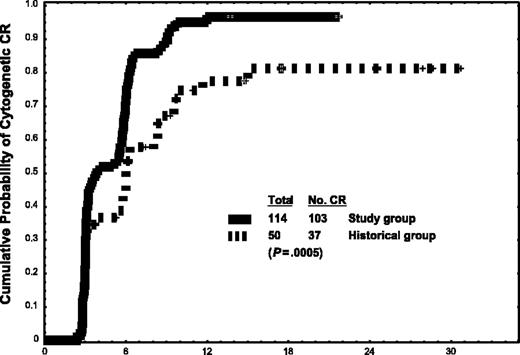
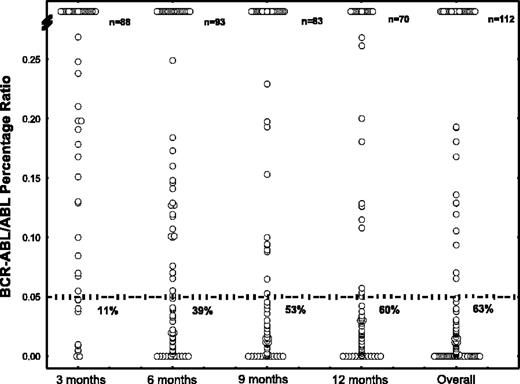
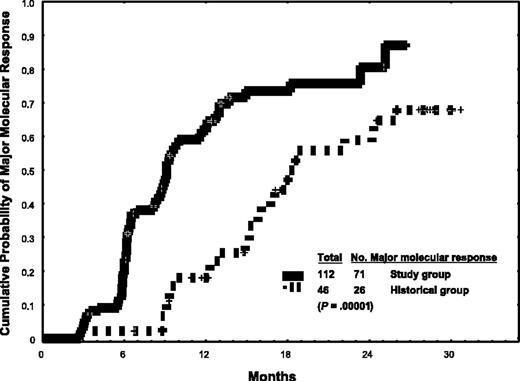
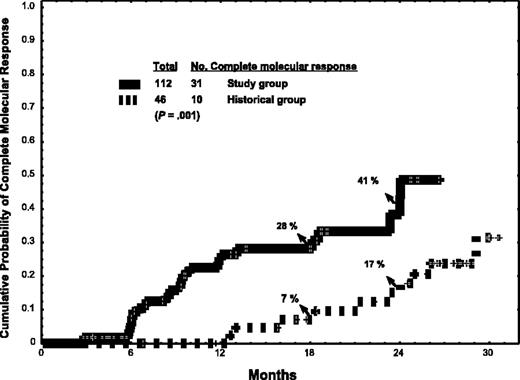
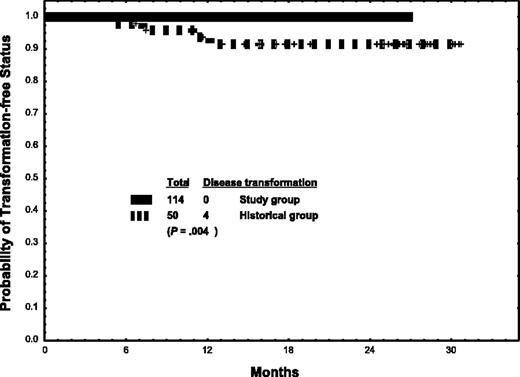

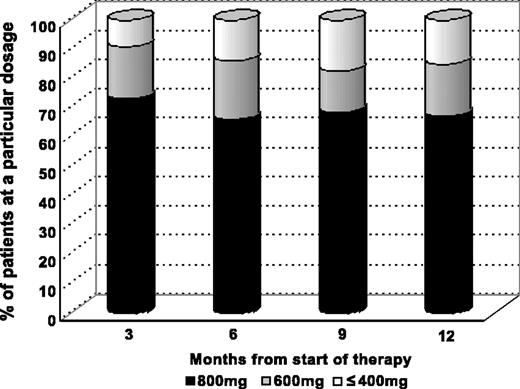
This feature is available to Subscribers Only
Sign In or Create an Account Close Modal